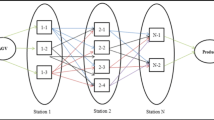Abstract
This paper considers operational issues that arise in repetitive manufacturing systems served by automated guided vehicles (AGVs) in loops with unidirectional material flow. The objective considered is the minimization of the steady state cycle time required to produce a minimal job set (or equivalently, throughput rate maximization). Our models allow for delays caused by AGV conflicts. We define and analyze three nondominated and widely used AGV dispatching policies. For each policy, we describe algorithms and intractability results for combined job scheduling and material handling problems. We describe a genetic algorithm that estimates the cycle time within 5% on average for instances with up to 10 machines and four AGVs. Some related fleet sizing and loop decomposition issues are discussed in the companion paper [19].
Similar content being viewed by others
References
R.G. Askin and C.R. Standridge, Modeling and Analysis of Manufacturing Systems (Wiley, New York, 1993).
J.J. Bartholdi, III, J.B. Orlin and H.D. Ratliff, Cyclic scheduling via integer programs with circular ones, Operations Research 28 (1980) 1074–1085.
J. Blazewicz, R.E. Burkard, G. Finke and G.J. Woeginger, Vehicle scheduling in two-cycle flexible manufacturing systems, Mathematical and Computer Modeling 20 (1994) 19–31.
J. Blazewicz, H.A. Eiselt, G. Finke, G. Laporte and J. Weglarz, Scheduling tasks and vehicles in a flexible manufacturing system, International Journal of Flexible Manufacturing Systems 4 (1991) 5–16.
Y.A. Bozer and M.M. Srinivasan, Tandem configurations for automated guided vehicle systems and the analysis of single vehicle loops, IIE Transactions 23 (1991) 72–82.
Y.A. Bozer and M.M. Srinivasan, Tandem AGV systems: A partitioning algorithm and performance comparison with conventional AGV systems, European Journal of Operational Research 63 (1992) 173–191.
C.-L. Chen, V.S. Vempati and N. Aljaber, An application of genetic algorithms for flowshop problems, European Journal of Operational Research 80 (1995) 389–396.
P.J. Egbelu and J.M.A. Tanchoco, Characterization of automatic guided vehicle dispatching rules, International Journal of Production Research 22 (1984) 359–374.
T. Ganesharajah, AGV-served manufacturing systems: Scheduling and design in loop layouts, Ph.D. thesis, Department of Mechanical and Industrial Engineering, University of Toronto (1997).
T. Ganesharajah, N.G. Hall and C. Sriskandarajah, Design and operational issues in AGV-served manufacturing systems, Annals of Operations Research 76 (1998) 109–154.
M.R. Garey and D.S. Johnson, Computers and Intractability: A Guide to the Theory of NP-Completeness (Freeman, New York, 1979).
P.C. Gilmore and R.E. Gomory, Sequencing a one state-variable machine: A solvable case of the traveling salesman problem, Operations Research 12 (1964) 665–679.
D.E. Goldberg, Genetic Algorithms in Search, Optimization and Machine Learning (Addison-Wesley, 1989).
L. Gould, Largest AGVS in North America transforms truck assembly, Modern Materials Handling 42 (1987) 58–63.
R.L. Graham, E.L. Lawler, J.K. Lenstra and A.H.G. Rinnooy Kan, Optimization and approximation in deterministic sequencing and scheduling: A survey, Annals of Discrete Mathematics 5 (1979) 287–326.
V. Grasso, AGV-served assembly lines: Influence of sequencing and launch policies on system performances, International Journal of Production Research 28 (1990) 1385–1399.
W. Grosseschallau and A. Kusiak, An expert system for design of automated material handling systems (INSIMAS), Material Flow 2 (1985) 157–166.
N.G. Hall, H. Kamoun and C. Sriskandarajah, Scheduling in robotic cells: Classification, two and three machine cells, Operations Research 45 (1997) 421–439.
N.G. Hall, C. Sriskandarajah and T. Ganesharajah, Operational decisions in AGV-served flowshop loops: Fleet sizing and decomposition, Annals of Operations Research 107 (2001) 189–209.
R.W. Hall, Cyclic scheduling for improvement, International Journal of Production Research 26 (1988) 457–472.
M.-H. Han and L.F. McGinnis, Control of material handling transporter in automated manufacturing, IIE Transactions 21 (1989) 184–190.
J.H. Holland, Adaptation in Natural and Artificial Systems (The University of Michigan Press, Ann Arbor, 1975).
H. Kise, T. Shioyama and T. Ibaraki, Automated two-machine flowshop scheduling: A solvable case, IIE Transactions 23 (1991) 10–16.
G.A. Koff, Automated guided vehicle systems: Applications, controls and planning, Material Flow 4 (1987) 3–16.
A. Kusiak, Material handling in flexible manufacturing systems, Material Flow 2 (1985) 79–95.
E.L. Lawler, J.K. Lenstra, A.H.G. Rinnooy Kan and D.B. Shmoys, The Traveling Salesman Problem: A Guided Tour of Combinatorial Optimization (Wiley, Chichester, UK, 1985).
W.L. Maxwell and J.A. Muckstadt, Design of automatic guided vehicle systems, IIE Transactions 14 (1982) 114–124.
Y. Monden, Toyota Production System (Institute of Industrial Engineers Press, Norcross, GA, 1983).
T. Murata and H. Ishibuchi, Performance evaluation of genetic algorithms for flowshop scheduling problems, in: Proceedings of the IEEE Conference on Genetic Algorithms (1994) pp. 812-817.
J.B. Orlin, A faster strongly polynomial minimum cost flow algorithm, Operations Research 41 (1993) 338–350.
S. Panwalkar, Scheduling of a two-machine flowshop with travel time between machines, Journal of the Operational Research Society 42 (1991) 609–613.
H.I. Stern and G. Vitner, Scheduling parts in a combined production-transportation work cell, Journal of the Operational Research Society 41 (1990) 625–632.
R.J. Wittrock, Scheduling algorithms for flexible flow lines, IBM Journal of Research and Development 29 (1985) 401–412.
J. Zygmont, Guided vehicles set manufacturing in motion, High Technology 16 (December 1986).
Author information
Authors and Affiliations
Rights and permissions
About this article
Cite this article
Hall, N.G., Sriskandarajah, C. & Ganesharajah, T. Operational Decisions in AGV-Served Flowshop Loops: Scheduling. Annals of Operations Research 107, 161–188 (2001). https://doi.org/10.1023/A:1014903232563
Issue Date:
DOI: https://doi.org/10.1023/A:1014903232563




